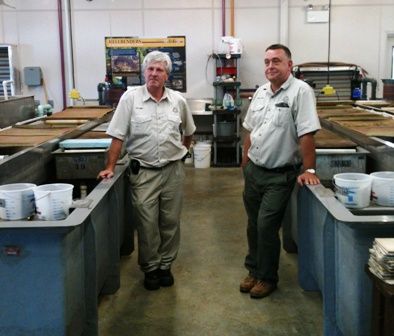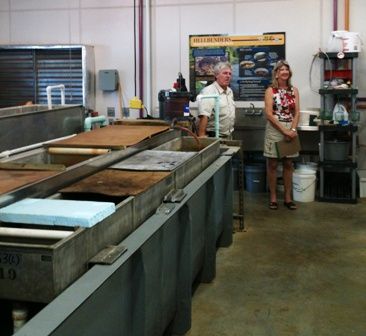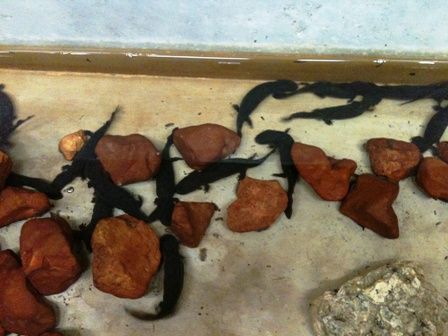|
Can We Help the Hellbender?
By Ronna Haxby, Missouri Projects Manager
The hellbender salamander has an unusual name and appearance, and they are one of the most interesting amphibians in the Ozarks! They also serve a valuable purpose: the "canary in the coal mine" for water quality. Hellbenders do have lungs but they mainly use them for buoyancy; instead they use loose fleshy folds of skin along their sides to pull oxygen from the water, which is how they breathe. Unfortunately they can absorb toxins and pollutants through their skin as well, which means they require clean, fresh water with high oxygen content in order to survive.
 | Eastern Hellbender with loose fleshy folds.
Photo Courtesy of MDC |
Some of you may recall our November 2010 newsletter article that David wrote about the Ozark Hellbender and its significant decline in population. It is a very informative article and will provide a great background for this story. If this decline continues the Ozark Hellbender will be extinct in 5 to 15 years. Click here to read the article. Luckily there are people trying to turn things around for these unusual and interesting amphibians.
 | | MDC's John Miller & James Civiello. |
John Miller, the Interpretive Center Manager for the Shepherd of the Hills Conservation Center and Fish Hatchery, and James Civiello, the coldwater Hatcheries Supervisor, recently gave myself and Branson's Environmental Specialist, Mona Menezes a tour of the hellbender hatchery. Missouri Department of Conservation (MDC) professionals were originally contacted by MDC herpetologist Jeff Briggler, the St. Louis Zoo, several university professionals and other agencies to become a part of the Ozark Hellbender Working Group recovery effort. They were asked in 2007 to become part of the propagation team and had a facility that was perfect for raising hellbenders.
 | | John Miller & Mona Menezes at the Shepherd of the Hills hellbender hatchery |
Unlike the majority of salamander species in the world, hellbenders have external fertilization similar to most fish species. The female hellbenders lay the eggs under large rocks and the males fertilize them. Another very interesting fact, unlike many other species, the male hellbender guards the nest and hatching larvae from predators.
MDC and other biologists, have been collecting fertilized eggs from various rivers over the past several years. Once the eggs are collected, they are transported to the Shepherd of the Hills Hatchery for incubation. After the eggs hatch, James Civiello will feed and care for the young Eastern Hellbenders for approximately 4-6 years before releasing them into the wild, while the St. Louis Zoo raises the young Ozark Hellbenders. They currently have about 700 Eastern Hellbenders in the hatchery. All juvenile hellbenders are released back into the Ozarks river where the eggs were collected. The Ozark Hellbenders are released into south flowing rivers and the Eastern Hellbenders are released into north flowing rivers.
 | | Young Eastern Hellbenders |
The hatchery uses some of the tanks to hold invertebrates collected from Lake Taneycomo for the young salamanders to eat. During the tour James reached into one of the tanks and scooped up a heaping, squirming handful of scuds and sow bugs.
 | | Scuds and sow bugs serve as food for the young hellbenders |
In addition to pollution, one of the challenges facing the hellbender is habitat removal and disturbance. They like to hide under large rocks in fast moving, clear water. This is also the kind of water that people love to float (myself included.) The outfitters will sometimes remove the big rocks on popular floating rivers like the Gasconade in order to improve the floating experience. This can be disruptive to the hellbender's habitat. One solution to this problem was to create fake rocks that were not such a problem to boaters. Luckily the salamanders accepted these man-made rocks and made themselves right at home.
One of the other interesting things about hellbenders is the toxic "slime" they excrete through their skin. (These proteins are actually on the international space station and are being studied to see how they react in zero gravity.) This bad tasting, milky secretion is likely to discourage being eaten by predators. To watch a very funny video of Dr. Brady Barr of the National Geographic Chanel licking a hellbender click HERE. It's also educational but I promise you will laugh!
Hellbenders also have another way to protect themselves from predators. They secrete phenomones as a way to communicate with one another. They release it when they feel threatened. For example when they smell a predator in the water they can warn one another of the danger.
Although hellbenders have innate recognition of many predators, captive reared hellbenders that are subsequently released into the wild have a higher rate of predation. These inexperienced juveniles show only weak recognition of introduced trout. Also these trout did not demonstrate a distaste for the bitter slime excreted by hellbenders during experiments.
Students from MSU did research in 2010 to see if hellbenders could be trained to avoid trout. When they exposed young hellbenders to trout scented water, there was not a dramatic reaction; it was inconclusive. They exposed young hellbenders to trout-scented water plus a hellbender distress secretion during training trials. In a subsequent test, these juveniles responded to trout cues alone with a fright response. This demonstrates that they can be trained to avoid potential introduced predators before being released. To read an abstract of the article click HERE. Also keeping the hellbenders at the hatchery for up to 6 years my increase their survival rate after being released.
Even with so many people working hard to help them, the jury is still out on the survival of Ozark Hellbenders. The "canary in the coal mine" is letting us know that our waters are not as clean as they could be. I hope we are able to respond to their warning, not just for the survival of this interesting creature but for the improved quality of our own lives. Whether you're a hellbender, a floater, an angler or just cooling off, there's nothing better than spending time on a clear, clean, cold Ozarks river!
For more information about Hellbenders you can contact: James.Civiello@mdc.mo.gov or Jeff.Briggler@mdc.mo.gov
|